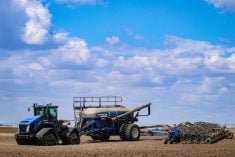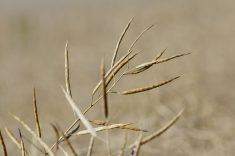Slapping federal quarantines on canola fields with verticillium wilt wouldn’t serve much purpose, since the yield-robbing fungi is already in all of Canada’s major canola-growing areas, the Canadian Food Inspection Agency says.
While the agency itself is recommending against regulation, CFIA on Wednesday posted a draft of a risk management document on verticillium wilt, seeking feedback from the public until May 15, to “help decide whether it is feasible to regulate this fungus.”
Up until it was spotted in a single Manitoba canola crop in 2014, V. longisporum — the fungus that causes verticillium wilt — had never been reported in any crops anywhere in Canada, nor on canola crops anywhere in North America.
Read Also

New opportunities for Canadian goods in Mexico
Agriculture minister’s trip to Mexico sees promotion of Canadian goods like beef and canola, with potential for more partnerships in the future
However, a nationwide survey of “more than 1,000” canola-stubble fields in all canola production areas in Canada, run from August through November 2015, has confirmed V. longisporum is “widely distributed” in most canola production areas in Canada.
Specifically, CFIA said, tests from the surveyed fields last year confirmed the fungus to be present in canola-growing areas not only in Manitoba, but in Alberta, Saskatchewan, British Columbia, Ontario and Quebec.
In all, 263 surveyed canola fields tested positive for the presence of V. longisporum DNA, CFIA said. Positive samples from Manitoba, Saskatchewan, Alberta and Ontario were found to belong to the same genotype; the genotype for samples from canola fields in B.C. and Quebec “was not determined.”
In the three other provinces surveyed — New Brunswick, Nova Scotia and Prince Edward Island — the fungus was not detected, CFIA said.
“Based on its widespread distribution, the CFIA has determined that V. longisporum does not meet the International Plant Protection Convention (IPPC) definition of a quarantine pest,” the agency said Wednesday.
Thus, CFIA said it won’t recommend adding V. longisporum to the List of Pests Regulated by Canada — a list which includes fungal diseases such as potato wart and Dutch elm disease, among other insects, molluscs, weeds and viral and fungal pests.
CFIA noted it had launched its pest risk assessment and national field survey for V. longisporum back when “it was unknown whether the fungus was established beyond the single confirmed site in Manitoba.”
Before the field survey had been completed, the pest risk assessment had found the fungus “could potentially meet the definition of a quarantine pest in Canada,” as it had the potential to cause economic harm to the canola industry, “both in terms of yield losses, as well as potential trade disruptions.”
V. longisporum, CFIA noted, was “previously known to occur” in association with cauliflower and horseradish crops in the U.S., and has been present in northern Europe for “several decades,” causing leaf chlorosis and premature ripening in affected winter oilseed rape crops.
The disease “has the potential to impact canola yields, with yield reductions highly correlated with disease severity.”
A soil-borne fungus, V. longisporum is “mainly spread by movement of infested soil and crop debris” and has also been reported to move with contaminated seed harvested from “heavily infested” fields.
The pathogen, CFIA said, survives through microsclerotia, a “resting” structure that can remain viable for periods of up to 10 years or more in soil or infested debris.
To “manage and reduce further spread” of V. longisporum in Canadian fields, CFIA said, “on-farm biosecurity measures appear to be the best approach.”
Biosecurity practices, according to the Canola Council of Canada, include “equipment and tool sanitation, controlling off-farm traffic, monitoring seed/feed/fertilizer sources, and developing an on-farm biosecurity plan.”
In the meantime, CFIA said, “naturally infested” canola crops will give researchers a “window of opportunity” to study the disease’s “epidemiology and management, risk mitigation, development and evaluation of resistant canola varieties and crop yield.” — AGCanada.com Network












